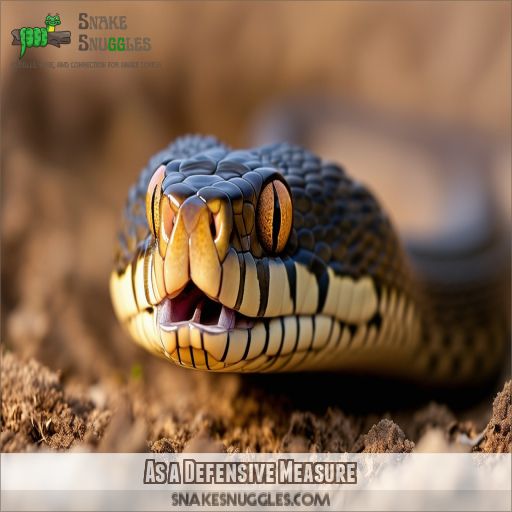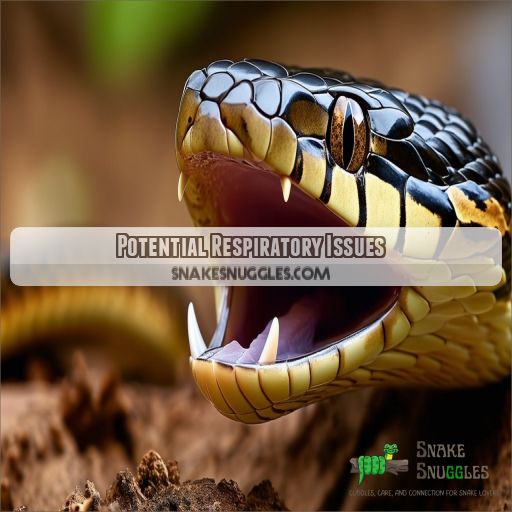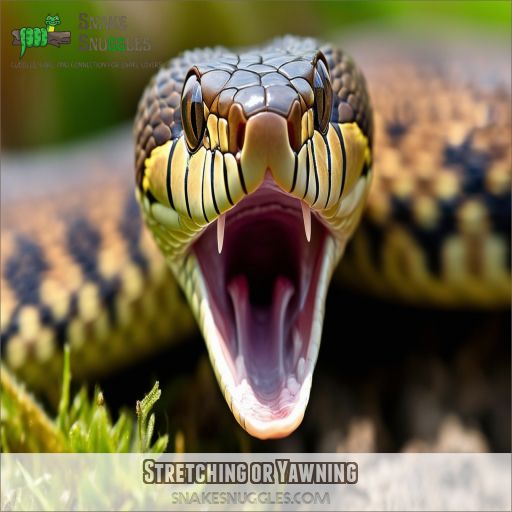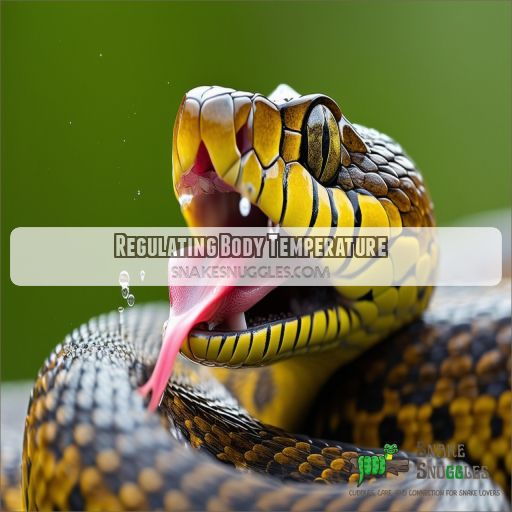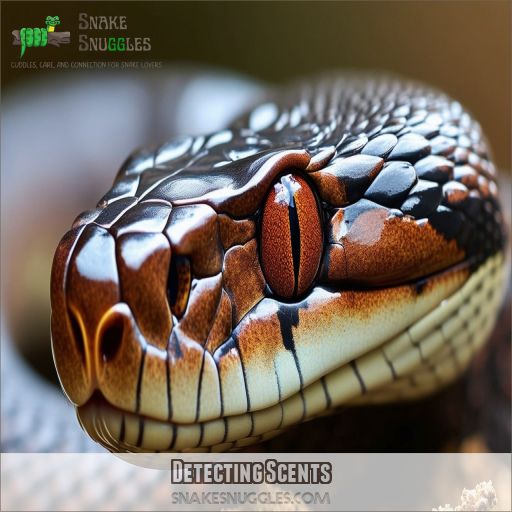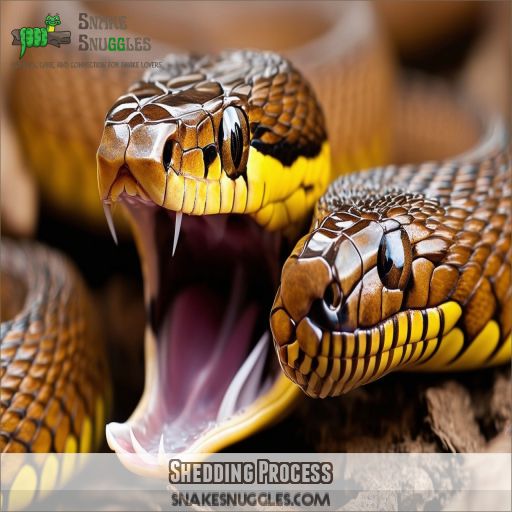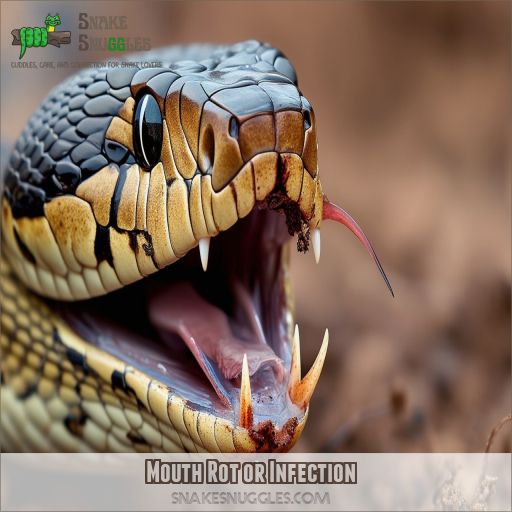This site is supported by our readers. We may earn a commission, at no cost to you, if you purchase through links.
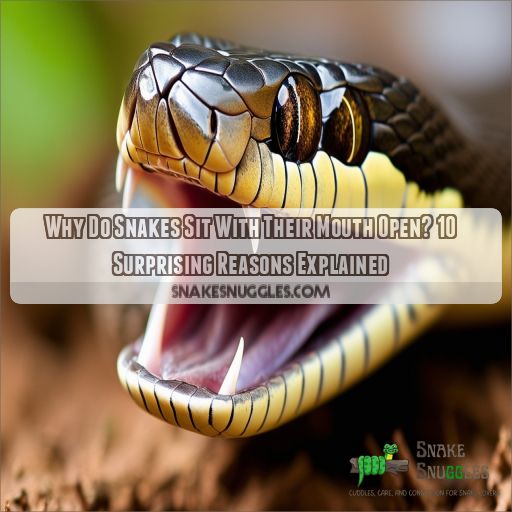
Snakes also gape to regulate body temperature, especially after meals. They could be detecting scents using their flicking tongue or might be in the shedding process.
Conditions like mouth rot or being overweight, which make it hard to close their mouth properly, could be culprits too. Curious about these reasons? Stick around for more.
Table Of Contents
- Key Takeaways
- Why Do Snakes Sit With Their Mouth Open?
- Preparing to Strike
- As a Defensive Measure
- Potential Respiratory Issues
- Stretching or Yawning
- Regulating Body Temperature
- Detecting Scents
- Shedding Process
- Mouth Rot or Infection
- Overweight Condition
- Structural Jaw Deformities
- Frequently Asked Questions (FAQs)
- What does it mean when a snake has its mouth open?
- Why do snakes stretch their mouths?
- Why is my snakes mouth stuck open?
- Why can snakes open their mouths so wide?
- Why do snakes sit with their mouth open?
- What if you sleep with your mouth open?
- Why do venomous snakes open their mouth?
- Do snakes open their mouths wide?
- How long do snakes sit with their mouths open?
- How does a snake’s mouth work?
- Can stress cause mouth opening in snakes?
- Should I handle a snake with an open mouth?
- How does mouth opening relate to snake digestion?
- Can environmental changes affect snake mouth behavior?
- Why does my snake rub its face often?
- Conclusion
Key Takeaways
- Snakes leaving their jaw on the floor can be a sign of many things, so don’t jump to conclusions! They might just be warming up their vocal cords for a chat or trying to cool down after a spicy meal.
- If your snake’s mouth is hanging open like a broken gate, don’t panic! It could be a sign of respiratory issues, but it’s best to consult a vet to rule out any underlying health problems.
- Just like us humans, snakes need to stretch their jaws sometimes. So, if you see your snake yawning or stretching its mouth, don’t worry – it’s just doing its morning yoga.
- If your snake’s mouth is open and you can see its tongue flicking in and out like a hummingbird’s, it’s probably just trying to get a whiff of the latest gossip in the snake world.
Why Do Snakes Sit With Their Mouth Open?
Snakes may sit with their mouths open for a variety of reasons, including (Source):
- Preparing to strike prey, 2) Regulating their body temperature, 3) Stretching or yawning, 4) Detecting scents, 5) Shedding their skin, 6) Respiratory issues, 7) Mouth infections, and 8) Structural jaw problems. Monitoring your snake’s behavior and environment can help determine the underlying cause.
Preparing to Strike
When a snake sits with its mouth open, it could be preparing to strike. This behavior is part of its hunting strategy, aimed at catching prey more efficiently. Snakes often exhibit jaw movement and expose their fangs, an impressive display that can be intimidating.
As saliva production increases, you’ll notice the snake flicking its tongue, sensing its environment before the attack. This jaw action enlarges their gape, making it easier to ensnare prey. It’s a blend of instinctual hunting behavior and a bit of defensive positioning.
Whether they’re poised on a branch or the ground, snakes use this technique to guarantee a swift and effective capture, showcasing nature’s powerful design.
As a Defensive Measure
Sometimes, you’ll see snakes sitting with their mouths open as a defensive measure. This seemingly aggressive behavior can actually be a stress response. Imagine a warning sign saying, “Back off!” It’s a territorial display, clearly communicating, “This is my space.”
During breeding behavior, the open mouth might serve as a deterrent to rivals. Think of it as a universal signal in the snake world, saying, “Stay away!”
However, if this mouth-opening becomes persistent, it could signal underlying issues such as infectious stomatitis (mouth rot). It’s important to address potential health problems promptly with proper veterinary care.
Potential Respiratory Issues
When a snake sits with its mouth open, it could indicate potential respiratory issues. Respiratory infections, such as sinus or lung infections, might be at play. Symptoms include wheezing, excess saliva, and labored breathing. Dehydration and pneumonia can exacerbate these issues. Sometimes, a foreign body blocking the airway or a sinus infection can cause open-mouth breathing.
To help your snake, make certain the enclosure’s temperature is around 80 degrees to regulate body temperature and humidity levels are at 50% or higher. If you notice any drainage or persistent symptoms, consult a reptile veterinarian. Diagnosing and treating respiratory problems promptly, including using antibiotics if necessary, can prevent further complications and ensure your snake’s health remains at its best.
Stretching or Yawning
As you’ve noted, snakes may sometimes sit with their mouths slightly open, and this behavior can actually be quite normal and harmless.
One potential explanation is that they may be yawning or stretching their jaws. Snakes don’t have the same jaw structure as mammals, so they need to periodically open their mouths wide to keep the muscles and joints flexible.
This stretching behavior is often observed after a meal, during the shedding process, or simply as the snake is waking up and becoming more active.
As long as there are no other concerning symptoms like excess saliva or discharge, this open-mouthed posture is likely just your snake engaging in some routine jaw exercises. Keep an eye on their overall health and behavior, but try not to worry too much about this particular quirk.
Regulating Body Temperature
Snakes regulate their body temperature by sitting with their mouth open, a behavior known as gaping. This action aids in temperature regulation and heat exchange, helping your snake maintain a proper body temperature.
Just like a radiator releases heat, gaping allows a snake to dispel excess heat, preventing overheating. Particularly in warm environments, this method is essential for thermoregulation, ensuring the snake doesn’t suffer from heat stress or related snake diseases.
Additionally, after a recent meal or during shedding (dysecdysis), this behavior can facilitate better heat loss and overall temperature control. Remember, if a snake appears consistently sick or overheated, it’s imperative to adjust their habitat’s temperature settings to promote their well-being.
Detecting Scents
While regulating body temperature helps explain why snakes open their mouths, another surprising reason involves detecting scents. Snakes use their mouths and tongues to gather environmental information. The process, known as chemical communication, leverages their advanced olfactory organs, the Jacobson’s organ. You’ll often see tongue flicking combined with an open mouth—this isn’t a sign of aggression but rather scent detection.
Snakes can identify pheromones from potential prey, mates, or even threats, using these chemical signals to navigate their world. This behavior also aids in acariasis management, detecting the presence of parasitic mites. So, when pondering "Why do snakes sit with their mouth open?" remember, it could simply be their way of making sense of their surroundings.
Shedding Process
During the shedding process, your snake might sit with its mouth open due to shedding difficulty. The old skin, including dry scales over nostrils, can cause skin irritation, making it feel itchy. Opening their mouth helps stretch the skin around the jaw, facilitating the shedding.
Sometimes, a stuck shed can occur, causing discomfort. Make sure the enclosure’s humidity is appropriate, around 50-60%, to aid in shedding. Misting the snake and providing a moist hide can help. Keep an eye on your snake for signs of struggle, like repeated open-mouth behavior, and gently assist if needed.
Proper environment maintenance can prevent these issues, ensuring a smooth shedding process for your pet.
Mouth Rot or Infection
Though shedding is a natural process for snakes, sitting with their mouth open might indicate a more serious issue—mouth rot or infection. This condition often stems from a bacterial or fungal infection, possibly exacerbated by a weakened immune system, an open wound, or dental disease. If your snake exhibits signs of mouth rot, you’ll usually notice inflamed gums, pus, or a foul odor coming from their mouth.
- Signs to Watch For:
- Swollen, red, or bleeding gums
- Presence of pus or mucus
- Difficulty swallowing or refusal to eat
- Visible open sores or lesions
Prompt veterinary attention can resolve these infections, ensuring your snake’s comfort and health. Remember, early intervention is key to preventing complications.
Overweight Condition
When your snake sits with its mouth open, it may be due to being overweight, which impacts its body functions. A hefty snake can struggle with breathing, causing it to leave its mouth open for easier inhalation. Adjusting your snake’s feeding habits is vital for weight loss. Feeding one large mouse every 14 days is recommended, paired with increased handling and exercise to promote a healthier weight.
Here’s a quick reference:
| Condition | Symptoms | Actions |
|---|---|---|
| Overweight Snake | Difficulty breathing, open mouth | Reduce feeding frequency |
| Weight Loss | Increased activity, reduced mouth gaping | More handling and exercise |
| Feeding Habits | Overfeeding leads to overweight | One large mouse every 14 days |
This structured approach helps guarantee your snake breathes easier and stays healthy.
Structural Jaw Deformities
If you’re converting from an overweight state, another potential reason for your snake resting with its mouth open could be structural jaw deformities.
Jaw alignment issues, whether innate or acquired over time, can disrupt normal jaw functionality. If a snake’s jaw shape, occlusion, or size isn’t properly aligned, it might struggle to close its mouth fully.
Problems with jaw growth could also manifest as a noticeable misalignment. These deformities can lead to difficulty eating or cause discomfort, prompting the snake to rest with its mouth open.
To determine if jaw deformities are the issue, a thorough examination by a reptile veterinarian is crucial. This step guarantees your pet receives specialized care and accurate diagnosis for jaw-related concerns.
Frequently Asked Questions (FAQs)
What does it mean when a snake has its mouth open?
A snake with its mouth open could indicate respiratory issues, overheating, or an object stuck in its mouth. If you notice this behavior, adjust the environment and seek veterinary advice to guarantee your snake’s health.
Why do snakes stretch their mouths?
Snakes stretch their mouths to realign their jaws, which can shift after eating or yawning. This behavior also helps them shed skin around their mouths or dislodge any stuck food or debris.
Why is my snakes mouth stuck open?
Your snake’s mouth may be stuck open due to respiratory infection, dehydration, or a foreign object lodged in its mouth. Immediate veterinary consultation is essential to diagnose and provide appropriate treatment for this worrying symptom.
Why can snakes open their mouths so wide?
Snakes can open their mouths so wide due to their uniquely flexible jaw structure, featuring highly mobile ligaments and bones. This adaptation allows them to consume prey much larger than their head in a single gulp.
Why do snakes sit with their mouth open?
Well, aren’t you observant? Your snake’s just showing off its new hobby—air gaping! More seriously, it likely indicates respiratory issues. It could be overheating, a stuck object, or underlying illness. Keep an eye on it!
What if you sleep with your mouth open?
Sleeping with your mouth open can cause dry mouth, bad breath, and a higher risk of dental problems. It might also trigger snoring or worsen sleep apnea, disrupting your sleep quality and overall health.
Why do venomous snakes open their mouth?
Venomous snakes, like cobras, open their mouths to hiss or display their fangs, intimidating predators or threats. This defensive behavior communicates, "I’m dangerous," reducing confrontations without wasting venom.
Do snakes open their mouths wide?
Snakes open their mouths wide for various reasons, including breathing, eating, or regulating body temperature. They might also display this behavior when stressed, aggressive, or experiencing health issues like respiratory infections.
How long do snakes sit with their mouths open?
Snakes might sit with their mouths open for varying lengths of time, from a few seconds to several minutes. If the behavior persists, especially with concerning symptoms, consult a reptile veterinarian to guarantee your snake’s well-being.
How does a snake’s mouth work?
A snake’s mouth hinges open widely, allowing it to consume prey larger than its head. Flexible ligaments, an extendable lower jaw, and backward-facing teeth help secure and swallow the prey effectively.
Can stress cause mouth opening in snakes?
Yes, stress can cause a snake to sit with its mouth open. This behavior often indicates environmental discomfort or illness, so verify the habitat’s temperature, humidity, and other conditions are ideal to reduce stress.
Should I handle a snake with an open mouth?
It’s better to play it safe and avoid handling a snake with its mouth open. This behavior could signal stress, respiratory issues, or aggression. Observe from a distance and seek veterinary advice if the condition persists.
How does mouth opening relate to snake digestion?
Mouth opening in snakes aids digestion by expelling excess heat produced during the metabolic process. It also adjusts jaw alignment after consuming large prey, ensuring normal function and facilitating easier respiration post-feeding.
Can environmental changes affect snake mouth behavior?
Environmental changes can dramatically affect your snake’s mouth behavior like a shifting weather front. Adjustments in temperature and humidity, imitating natural habitats, can alleviate behaviors like gaping, signaling respiratory conditions or overheating.
Why does my snake rub its face often?
Your snake rubs its face frequently likely due to shedding, irritation from mites, or an uncomfortable environment. Monitor humidity and temperature, inspect for mites, and provide rough surfaces to aid shedding.
Conclusion
While it might seem alarming, understanding why snakes sit with their mouth open can help you identify their needs or potential health issues.
From preparing to strike or defend, managing body functions, stretching, to possible infections or deformities, each reason serves a purpose.
Observing your snake’s behavior with these insights guarantees you can respond appropriately. Recognizing these signs aids in their care and ensures a safe and healthy environment for your reptilian companion.


